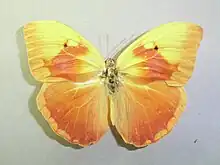| Phoebis | |
|---|---|
 | |
| Phoebis avellaneda | |
| Scientific classification | |
| Domain: | Eukaryota |
| Kingdom: | Animalia |
| Phylum: | Arthropoda |
| Class: | Insecta |
| Order: | Lepidoptera |
| Family: | Pieridae |
| Tribe: | Coliadini |
| Genus: | Phoebis Hübner, [1819] |
| Species | |
| Synonyms | |
| |
Phoebis, or sulphurs, is a genus of butterflies, belonging to the subfamily Coliadinae of the "whites" or family Pieridae. They are native to the Americas.
Selected species
- Phoebis agarithe (Boisduval, [1836]) – large orange sulphur (southern US to Peru)
- Phoebis argante (Fabricius, 1775) – apricot sulphur, Argante giant sulphur (Mexico to Peru and Brazil, Caribbean)
- Phoebis avellaneda (Herrich-Schäffer, 1865) – red-splashed sulphur (Cuba)
- Phoebis bourkei (Dixey, 1933) – (Ecuador)
- Phoebis editha (Butler, 1870) – Edith's sulphur (Haiti)
- Phoebis neocypris (Hübner, [1823]) – tailed sulphur (Mexico to Peru, Brazil)
- Phoebis philea (Linnaeus, 1763) – orange-barred sulphur, yellow apricot (Mexico to Peru, Brazil, Cuba, Hispaniola)
- Phoebis sennae (Linnaeus, 1758) – cloudless
sulphur, common yellow (southern North America to South America)
Moved:
- Phoebis orbis moved to Aphrissa orbis (Poey, 1832) – orbed sulphur
References
Gallery
This article is issued from Wikipedia. The text is licensed under Creative Commons - Attribution - Sharealike. Additional terms may apply for the media files.

